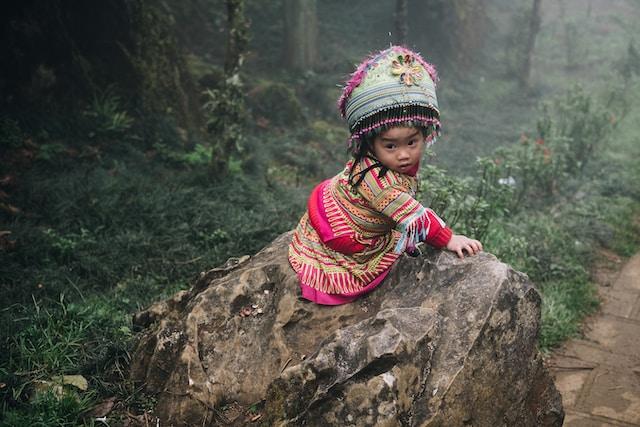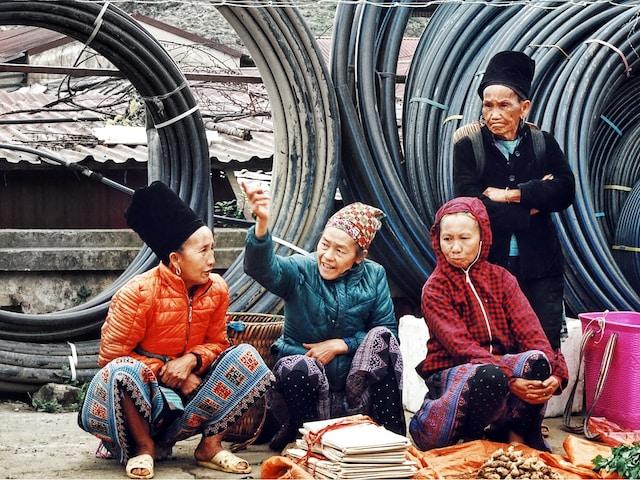Ha Giang, a remote province located in the northernmost part of Vietnam, is not only blessed with breathtaking landscapes but also with a rich tapestry of ethnic diversity. Home to numerous ethnic minority groups, Ha Giang offers a unique opportunity to immerse oneself in vibrant cultures, ancient traditions, and warm hospitality. Today, we will embark on a captivating journey to discover the ethnic communities in Ha Giang. From the colourful markets and traditional villages to the fascinating rituals and festivals, let us unravel the cultural treasures that make Ha Giang an unforgetful destination.
Five Well-known Ethnic Communities in Ha Giang
Dao Ethnic Community
The Dao ethnic community in Ha Giang possesses a rich cultural heritage deeply rooted in their spiritual beliefs, medicinal practices, and craftsmanship. The Dao people are known for their knowledge of traditional medicine and the use of herbs for healing. Visitors can explore Dao villages, such as Nam Dam and Ta Phin, and interact with Dao healers to learn about their remedies and medicinal plants.
The Dao people also excel in craftsmanship, particularly in silver jewellery making. Visitors can observe their intricate silverwork and even participate in workshops to create their unique pieces under the guidance of Dao artisans. The Cap Sac ceremony, an important rite of passage in the Dao community, is another fascinating cultural event to witness. During this ceremony, young Dao men officially become adults through rituals, feasting, and communal celebrations.
Hmong Ethnic Community

The Hmong ethnic community is one of the largest and most prominent groups in Ha Giang. They have a distinct cultural identity that is visible in their clothing, language, and traditions. The Hmong people are skilled in intricate embroidery, and their vibrant clothing showcases their artistic talents. Visitors can explore traditional Hmong villages, such as Ta Phin and Cat Cat, to witness their way of life. Engaging in a Hmong homestay provides an immersive experience where guests can learn about their customs, try traditional dishes, and participate in daily activities.
A significant cultural event in the Hmong community is the Long Tong festival, celebrated at the beginning of the lunar year. During this festival, the Hmong express gratitude to their ancestors, perform traditional dances, and engage in various rituals. Visitors can join in the festivities, witness the vibrant costumes, and experience the lively atmosphere that permeates the Hmong villages during this time.
Tay Ethnic Community
The Tay ethnic community, predominantly residing in the valleys and lowlands of Ha Giang, possesses a rich agricultural heritage and expertise in traditional crafts. Visitors can explore Tay villages like Ban Dan and Nam Hoong to experience their unique way of life. The Tay people are skilled in rice cultivation and terraced farming, and visitors can participate in activities such as rice planting and harvesting, as well as learning about their agricultural techniques.
The Tay people’s stilt houses, made from natural materials and adorned with intricate carvings, showcase their architectural prowess. Visitors can stay in homestays to experience their hospitality firsthand and learn about their daily activities. The Tay community’s culinary traditions are also noteworthy, with dishes prepared using locally sourced ingredients, such as grilled fish and bamboo shoots. Food enthusiasts can join cooking classes to learn the secrets of Tay cuisine.
Lo Lo Ethnic Community
The Lo Lo ethnic community, residing in the remote mountainous regions of Ha Giang, holds a unique place in the cultural fabric of the province. The Lo Lo people are known for their distinctive architecture, with their houses featuring stone walls and thatched roofs. Visitors can trek to Lo Lo villages like Lung Cu and Hoang Su Phi to witness their exceptional craftsmanship and experience their traditional way of life.
Traditional Lo Lo costumes, characterized by bright colours and intricate patterns, are a testament to their rich cultural heritage. Visitors can admire their textiles, learn about their weaving techniques, and even try their hand at traditional weaving methods. The Lo Lo people also celebrate various festivals, such as the Gau Tao Festival, which involves rituals, music, dance, and traditional performances that offer a fascinating insight into their spiritual beliefs and cultural traditions.
Giay Ethnic Community
The Giay ethnic community, residing primarily in the valleys and terraced fields of Ha Giang, presents a vibrant cultural tapestry centred around their traditional festivals, craftsmanship, and agricultural practices. Visitors can explore Giay villages like Nam Hong and Ta Van Chu to witness their exceptional weaving skills. The Giay people are renowned for their intricate textiles, and visitors can observe the process of dyeing, spinning, and weaving that goes into creating their beautiful fabrics.
The Giay community’s lively festivals, such as the Roong Pooc Festival, showcase their vibrant traditions through music, dance, and colourful costumes. Visitors can witness traditional performances, taste delicious Giay cuisine, and join in the festivities to experience the warmth and joy that emanate from these celebrations. The Giay people’s deep connection with nature is evident in their farming practices, and visitors can participate in activities like rice planting and traditional farming methods.
The Northern region province stands as a cultural treasure trove, offering a window into the diverse ethnic communities in Ha Giang that call this region home. The Hmong, Dao, Tay, Lo Lo, and Giay communities showcase their unique customs, traditions, and craftsmanship, providing visitors with an immersive cultural experience. From witnessing the vibrant festivals and participating in traditional rituals to exploring traditional villages and trying local cuisine, ethnic communities in Ha Giang offer an unforgettable journey of cultural discovery. By embracing the rich cultural diversity of Ha Giang, visitors gain a deeper appreciation for the region’s heritage and the resilience of its ethnic communities.
Looking to go deeper into the mountains? Check out our guide on everything you need to know about the Ha Giang Loop!

